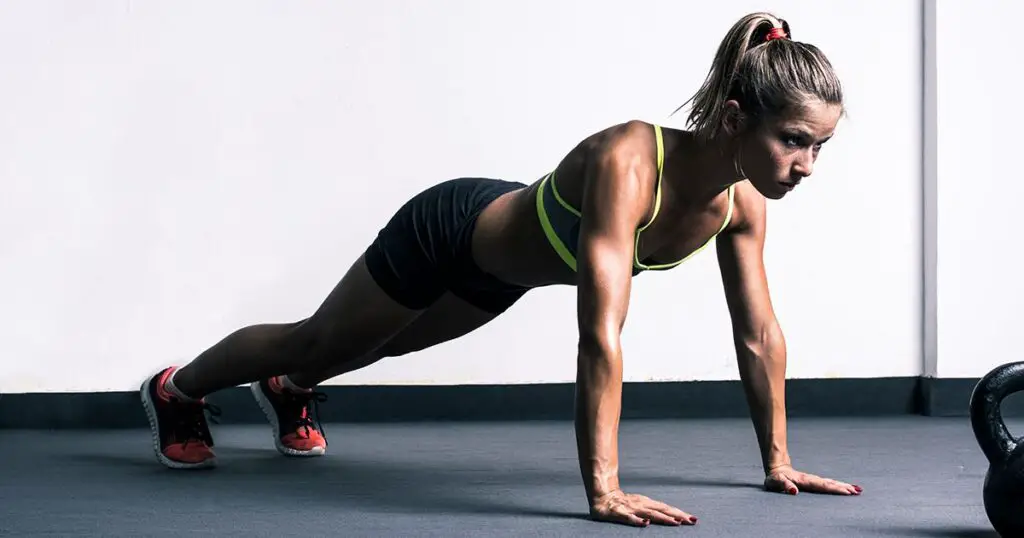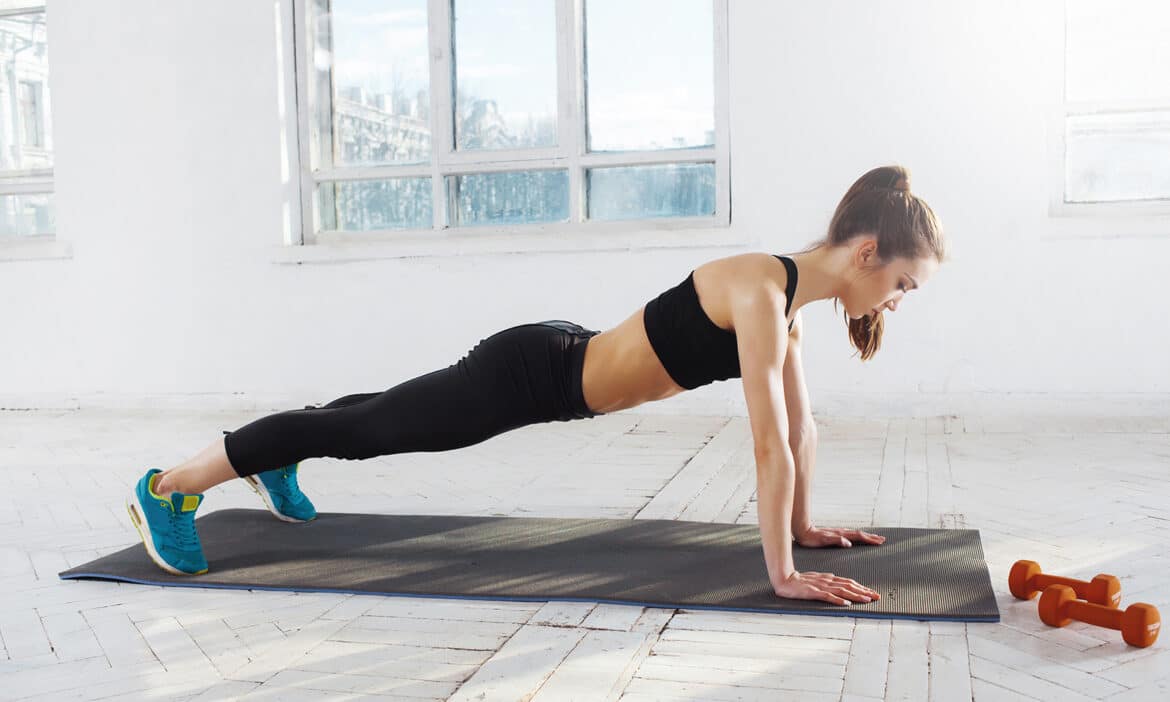Introduction
Does Pushups Burn Fat: The humble push-up, a staple in fitness routines around the world, is not only an excellent exercise for building strength but has also gained attention for its potential role in fat burning. Push-ups are celebrated for their versatility and accessibility, as they require no special equipment and can be performed virtually anywhere. This bodyweight exercise engages several major muscle groups, making it a fantastic addition to your workout routine. Does Pushups Burn Fat? But the question that often arises is whether push-ups are effective at burning fat. We will delve into the relationship between push-ups and fat loss, shedding light on the science behind the exercise and how it contributes to a healthier, more lean physique.
Push-ups have been lauded for their ability to increase muscle mass and metabolic rate, which can play a significant role in fat burning. As a compound movement, they engage the chest, shoulders, triceps, and core muscles, promoting muscular development and strength. This added muscle mass, in turn, increases your basal metabolic rate, meaning you burn more calories at rest. However, to fully understand the fat-burning potential of push-ups, we need to consider factors such as intensity, consistency, and their role within a comprehensive fitness regimen.
Push-ups alone may not be a panacea for fat loss. While they can contribute to a healthier, more toned body, their effectiveness in reducing body fat depends on various factors, including dietary habits, overall physical activity, and individual metabolism. To provide a holistic view, we will explore how incorporating push-ups into a balanced fitness and nutrition program can synergize with other strategies to help you achieve your fat loss goals.

Do push-ups burn belly fat?
Because push-ups mainly focus on the muscles of the upper body, they have relatively little direct impact on the abdominal area. Push-ups help reduce belly fat if and only if the calories burned during exercise are enough to convert fat loss and increase abdominal muscle.
Overall Calorie Expenditure: Engaging in regular physical activity, such as push-ups and other forms of exercise, increases your total calorie expenditure. This, in turn, can contribute to an overall reduction in body fat, including fat in the abdominal area.
Healthy Eating Habits: Maintaining a balanced diet with a caloric intake appropriate for your goals is crucial for fat loss. Reducing overall calorie intake, eating nutrient-dense foods, and controlling portion sizes can help you create a calorie deficit, which is essential for fat loss.
Aerobic Exercise: Incorporating cardiovascular exercises like running, cycling, or swimming into your routine can help you burn more calories and further contribute to fat loss throughout the body, including the abdominal area.
Consistency: Consistent exercise and a sustained caloric deficit are key to achieving and maintaining fat loss results.
Genetics and Hormones: Genetics and hormonal factors play a role in where your body tends to store and lose fat. For some individuals, the abdominal area may be a particularly stubborn area for fat loss.
Is 100 pushups a day enough to lose weight?
To lose body fat, you must focus on your nutrition. 100 push-ups, 100-sit-ups, and 100 squats will not help you lose body fat. If combined with a proper nutrition these physical exercises can speed up the process of fat loss. It is all about diet and lifestyle.
Caloric Expenditure: While push-ups are a great bodyweight exercise that engages multiple muscle groups, they do not burn a substantial number of calories. The number of calories burned during 100 push-ups is relatively modest compared to what can be achieved through aerobic activities like running, cycling, or swimming.
Muscle Building: Regular push-ups can help build muscle, which can increase your metabolic rate over time. Muscle tissue burns more calories at rest than fat tissue. However, muscle gain through resistance training may not result in immediate weight loss, as muscle is denser and can initially offset any fat loss.
Diet: Weight loss is strongly influenced by your diet. To lose weight effectively, it’s essential to maintain a healthy, balanced diet that creates a caloric deficit. Reducing overall calorie intake, monitoring portion sizes, and making nutritious food choices are key components of successful weight loss.
Aerobic Exercise: While push-ups are beneficial for building muscle, including cardiovascular exercises (e.g., running, brisk walking, cycling) in your routine can significantly boost your calorie expenditure and help create the necessary calorie deficit for weight loss.
Consistency: Consistency in both exercise and diet is essential for achieving and maintaining weight loss results.
Does Hindu pushups burn belly fat?
However, Hindu push-ups can be an effective full-body workout that can contribute to overall weight loss and muscle tone. Here are some ways that Hindu push-ups may help: Belly fat: Hindu push-ups can engage the core muscles, including the abs, which can help tone and tighten the belly area.
Caloric Deficit: Achieving fat loss requires creating a caloric deficit, where you burn more calories than you consume. Reducing overall calorie intake and maintaining a balanced diet can help you create this deficit.
Aerobic Exercise: While strength and resistance exercises like Hindu pushups can help you build muscle and increase metabolic rate, incorporating aerobic exercises like running, jogging, cycling, or swimming into your routine can burn additional calories and facilitate fat loss.
Consistency: Consistent exercise and dietary habits are essential for achieving and maintaining fat loss results.
Genetics and Hormones: Genetics and hormonal factors can influence where your body tends to store and lose fat. For some individuals, the abdominal area may be a stubborn area for fat loss.
Is 20 push-ups a day enough?
Many people do more than 300 push-ups a day. But for an average person, even 50 to 100 push-ups should be enough to maintain a good upper body, provided it is done properly. You can start with 20 push-ups, but do not stick to this number. It is important to keep increasing the number to challenge your body.
Strength and Endurance: Regularly doing 20 push-ups a day will help maintain and possibly improve your upper body strength and endurance. However, for significant muscle growth and strength gains, you may need to gradually increase the number of push-ups and incorporate variations that challenge your muscles more.
Weight Loss: If your primary goal is weight loss, 20 push-ups alone may not provide enough calorie expenditure to make a significant impact. Combining push-ups with other forms of exercise, particularly cardiovascular activities like running, cycling, or swimming, can be more effective for weight loss.
Progressive Overload: To continue seeing results and improvements in strength and fitness, you’ll need to progressively increase the intensity of your push-up routine. This can be done by adding more repetitions, performing more challenging push-up variations, or incorporating additional exercises into your routine.
Variation: Consider adding variety to your exercise routine to engage different muscle groups and keep your workouts interesting and effective. This can include different push-up variations and other strength training exercises.
Consistency: Consistency is key to seeing and maintaining results in fitness. Make exercise a regular part of your daily or weekly routine.
Which is better plank or push up?
That makes push-ups harder than planks, as more upper-body strength is required. Accordingly, push-ups can do more to build upper body strength than planks can. To achieve the best level of fitness, you’ll benefit from doing both exercises.
Planks: Planks are primarily an isometric exercise that focuses on core strength and stability. They engage the muscles of the core, including the rectus abdominis, transverse abdominis, obliques, and the muscles of the lower back. Planks are excellent for improving core strength, reducing the risk of lower back pain, and enhancing overall stability. They are particularly effective at developing endurance in the core muscles, which is essential for maintaining proper posture and spinal alignment.
Push-Ups: Push-ups are a dynamic exercise that engages multiple muscle groups, including the chest, shoulders, triceps, and core. They provide a full-body workout that not only strengthens the upper body but also helps develop overall upper body endurance. Push-ups are a versatile exercise that can be modified to target different muscle groups or to increase or decrease the intensity. They are effective for building chest and tricep strength and improving muscular endurance.
How many push-ups is good for weight loss?
Doing 40-50 push-ups every day can help you lose weight, but it is not the only thing you need to do. Weight loss is achieved by burning more calories than you consume. Push-ups burn calories, but not as many as other forms of exercise, such as running or swimming.
Diet: Focus on maintaining a balanced, calorie-controlled diet. Reducing your overall calorie intake, making healthy food choices, and controlling portion sizes are essential for creating a caloric deficit.
Aerobic Exercise: Incorporate cardiovascular exercises like running, jogging, cycling, or swimming into your routine. These exercises burn more calories and can contribute significantly to weight loss.
Strength Training: Include resistance and strength training exercises, like push-ups, to build muscle. Muscle tissue burns more calories at rest than fat tissue, so having more muscle can help increase your metabolic rate and support weight loss.
Consistency: Consistency in both exercise and dietary habits is essential for achieving and maintaining weight loss results.
Which pushup is best for belly fat?
Knee Pushups Exercise
Knee pushups are a great way to reduce belly fat. This exercise targets the abdominal muscles and requires no equipment, one can easily do this exercise at home. You can adapt your workout according to your fitness level because this can be done at any pace.
Caloric Deficit: Weight loss, including belly fat loss, requires creating a caloric deficit by burning more calories than you consume. To achieve this, monitor your calorie intake and maintain a balanced diet.
Cardiovascular Exercise: Incorporate aerobic activities like running, cycling, or swimming into your routine. These exercises burn more calories and promote overall fat loss, including in the abdominal area.
Strength Training: While push-ups alone won’t target belly fat, strength training exercises like push-ups can help build muscle. More muscle increases your metabolic rate, which may facilitate fat loss over time.
Healthy Diet: Consume a balanced diet with a focus on whole foods, lean proteins, fruits, vegetables, and controlled portions. Reducing processed foods, sugar, and refined carbohydrates can support fat loss.
Consistency: Consistency in both exercise and dietary habits is vital for achieving and maintaining results.
Stress Management: High stress levels can lead to the accumulation of belly fat. Practicing stress-reduction techniques like yoga, meditation, or deep breathing exercises can be beneficial.
Sleep: Ensure you get adequate sleep, as sleep quality can impact hormone regulation and, consequently, fat storage.
Is it safe to burn 2000 calories a day?
Risk of burnout: Burning 2000 calories a day can also lead to feelings of fatigue and burnout, as your body is expending a significant amount of energy. It’s important to listen to your body and take breaks as needed to avoid overtraining.
Individual Needs: Daily calorie needs vary from person to person. A daily caloric intake of 2,000 calories might be appropriate for one person but excessive or insufficient for another. It’s important to determine your specific caloric needs based on your age, weight, activity level, and overall health goals.
Balanced Approach: Rather than focusing solely on burning calories, it’s important to take a balanced approach to health and fitness. This includes consuming a well-balanced diet, staying hydrated, and engaging in a mix of cardiovascular exercise, strength training, and flexibility exercises.
Gradual Changes: Making significant changes in calorie expenditure or intake should be done gradually and under the guidance of a healthcare professional or certified fitness expert. Rapid and extreme changes can have adverse effects on your metabolism and overall health.
Health and Safety: Safety is paramount. It’s crucial to prioritize your overall health and well-being. Pushing yourself to burn excessive calories through exercise, especially without proper rest and nutrition, can lead to overtraining, injuries, and other health issues.
Nutrition: Nutrition plays a key role in health and weight management. Ensure you are consuming a balanced diet that meets your energy needs and provides the necessary nutrients to support your activities.

Conclusion
Push-ups are a versatile and effective exercise that can play a valuable role in a comprehensive fitness routine, including weight loss and fat burning. While they are primarily known for building upper body strength and muscle endurance, push-ups also engage a variety of muscle groups, including the chest, shoulders, triceps, core, and even the lower body. Muscle engagement means that push-ups can help increase your overall calorie expenditure and contribute to fat loss, especially when combined with a well-balanced diet and other forms of cardiovascular exercise.
It’s important to note that spot reduction, the idea that you can burn fat in specific areas by exercising those areas, is a common misconception. Fat loss occurs throughout the body as a whole, and push-ups alone won’t specifically target fat loss in the chest or arms. To see significant results, a holistic approach to fitness, which includes both strength training and cardiovascular exercises, alongside a proper diet, is essential.
Push-ups are a valuable component of a well-rounded fitness program that can aid in fat loss by increasing your overall metabolic rate and helping you build lean muscle. Combined with a balanced diet and regular aerobic exercise, they can contribute to a healthier, more sustainable approach to fat loss and improved overall fitness.

